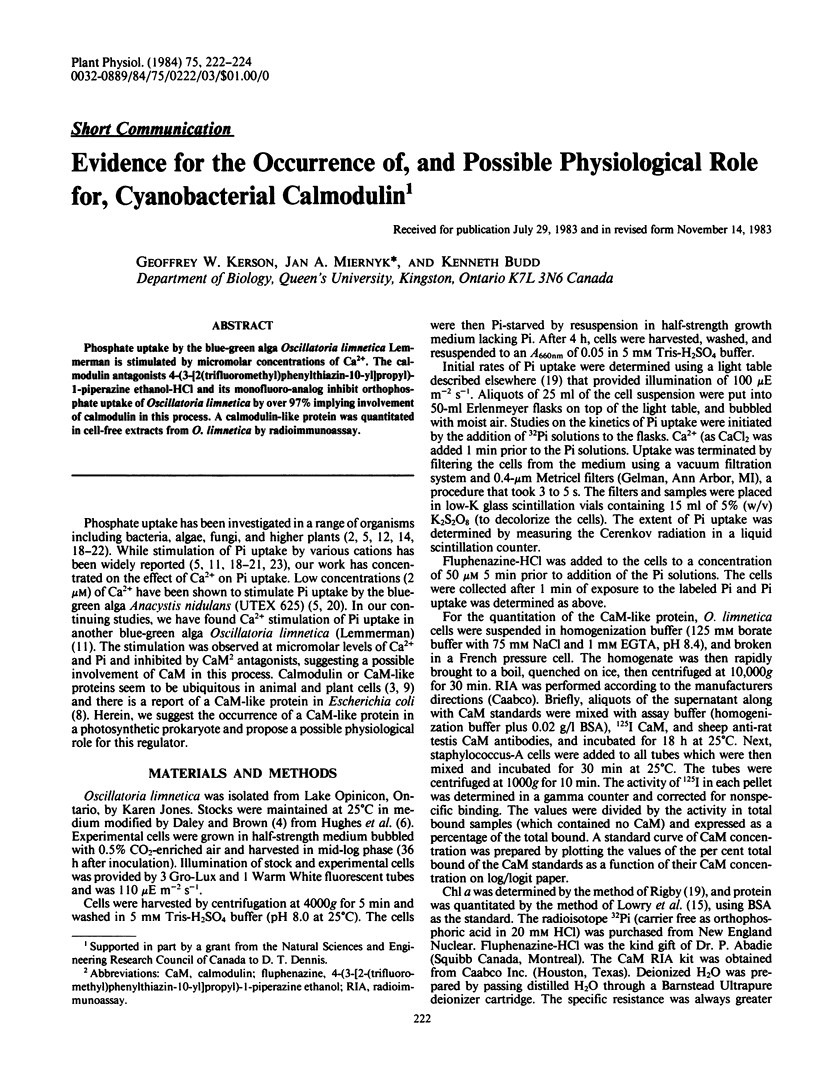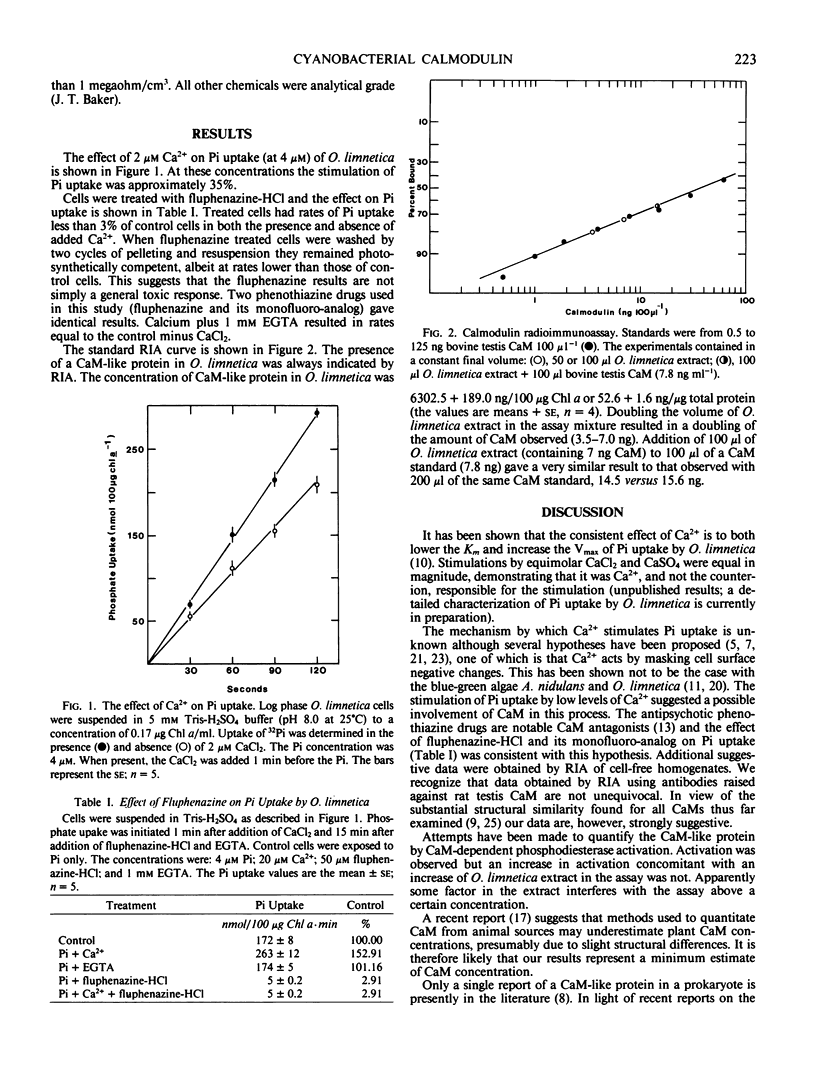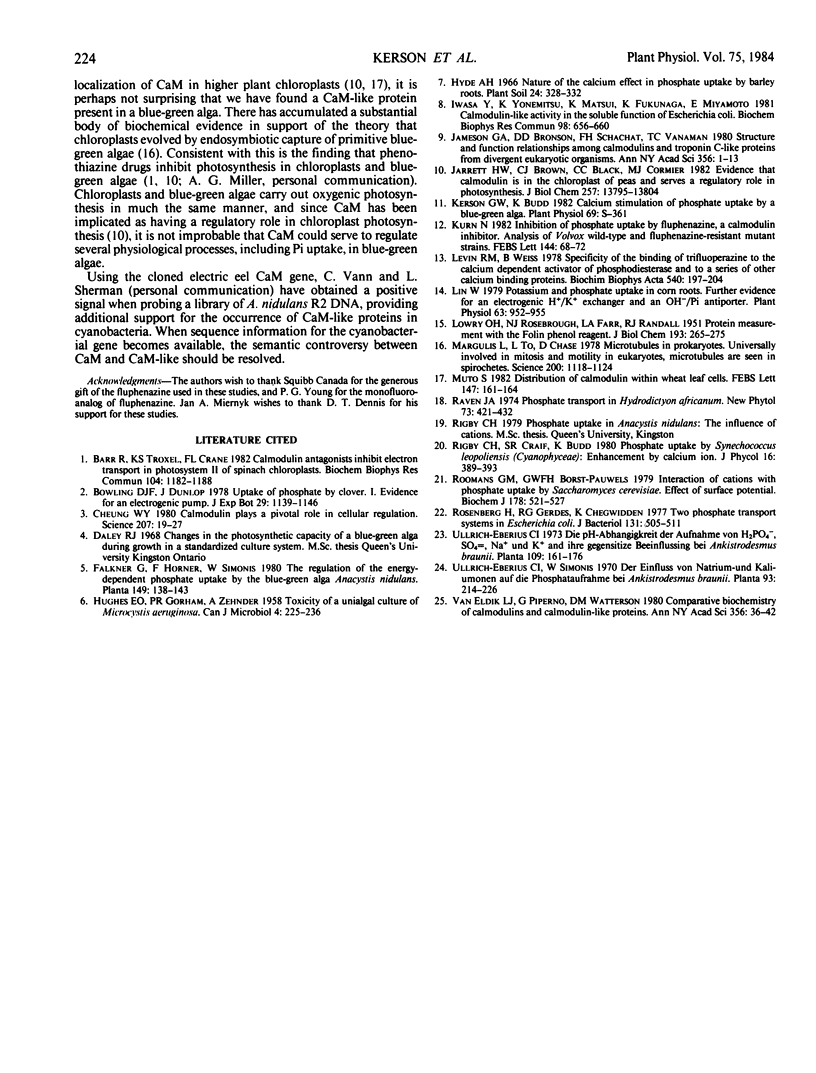Abstract
Phosphate uptake by the blue-green alga Oscillatoria limnetica Lemmerman is stimulated by micromolar concentrations of Ca2+. The calmodulin antagonists 4-(3-[2(trifluoromethyl)phenylthiazin-10-yl]propyl)-1-piperazine ethanol-HCl and its monofluoro-analog inhibit orthophosphate uptake of Oscillatoria limnetica by over 97% implying involvement of calmodulin in this process. A calmodulin-like protein was quantitated in cell-free extracts from O. limnetica by radioimmunoassay.
Full text
PDF


Selected References
These references are in PubMed. This may not be the complete list of references from this article.
- Barr R., Troxel K. S., Crane F. L. Calmodulin antagonists inhibit electron transport in photosystem II of spinach chloroplasts. Biochem Biophys Res Commun. 1982 Feb 26;104(4):1182–1188. doi: 10.1016/0006-291x(82)91375-4. [DOI] [PubMed] [Google Scholar]
- Cheung W. Y. Calmodulin plays a pivotal role in cellular regulation. Science. 1980 Jan 4;207(4426):19–27. doi: 10.1126/science.6243188. [DOI] [PubMed] [Google Scholar]
- HUGHES E. O., GORHAM P. R., ZEHNDER A. Toxicity of a unialgal culture of Microcystis aeruginosa. Can J Microbiol. 1958 Jun;4(3):225–236. doi: 10.1139/m58-024. [DOI] [PubMed] [Google Scholar]
- Iwasa Y., Yonemitsu K., Matsui K., Fukunaga K., Miyamoto E. Calmodulin-like activity in the soluble fraction of Escherichia coli. Biochem Biophys Res Commun. 1981 Feb 12;98(3):656–660. doi: 10.1016/0006-291x(81)91164-5. [DOI] [PubMed] [Google Scholar]
- Jamieson G. A., Jr, Bronson D. D., Schachat F. H., Vanaman T. C. Structure and function relationships among calmodulins and troponin C-like proteins from divergent eukaryotic organisms. Ann N Y Acad Sci. 1980;356:1–13. doi: 10.1111/j.1749-6632.1980.tb29593.x. [DOI] [PubMed] [Google Scholar]
- Jarrett H. W., Brown C. J., Black C. C., Cormier M. J. Evidence that calmodulin is in the chloroplast of peas and serves a regulatory role in photosynthesis. J Biol Chem. 1982 Nov 25;257(22):13795–13804. [PubMed] [Google Scholar]
- Kurn N. Inhibition of phosphate uptake by fluphenazine, a calmodulin inhibitor. Analysis of Volvox wild-type and fluphenazine-resistant mutant strains. FEBS Lett. 1982 Jul 19;144(1):68–72. doi: 10.1016/0014-5793(82)80570-x. [DOI] [PubMed] [Google Scholar]
- LOWRY O. H., ROSEBROUGH N. J., FARR A. L., RANDALL R. J. Protein measurement with the Folin phenol reagent. J Biol Chem. 1951 Nov;193(1):265–275. [PubMed] [Google Scholar]
- Levin R. M., Weiss B. Specificity of the binding of trifluoperazine to the calcium-dependent activator of phosphodiesterase and to a series of other calcium-binding proteins. Biochim Biophys Acta. 1978 May 3;540(2):197–204. doi: 10.1016/0304-4165(78)90132-0. [DOI] [PubMed] [Google Scholar]
- Lin W. Potassium and Phosphate Uptake in Corn Roots: Further Evidence for an Electrogenic H/K Exchanger and an OH/Pi Antiporter. Plant Physiol. 1979 May;63(5):952–955. doi: 10.1104/pp.63.5.952. [DOI] [PMC free article] [PubMed] [Google Scholar]
- Roomans G. M., Borst-Pauwels G. W. Interaction of cations with phosphate uptake by Saccharomyces cerevisiae. Effects of surface potential. Biochem J. 1979 Mar 15;178(3):521–527. doi: 10.1042/bj1780521. [DOI] [PMC free article] [PubMed] [Google Scholar]
- Rosenberg H., Gerdes R. G., Chegwidden K. Two systems for the uptake of phosphate in Escherichia coli. J Bacteriol. 1977 Aug;131(2):505–511. doi: 10.1128/jb.131.2.505-511.1977. [DOI] [PMC free article] [PubMed] [Google Scholar]
- Van Eldik L. J., Piperno G., Watterson D. M. Comparative biochemistry of calmodulins and calmodulin-like proteins. Ann N Y Acad Sci. 1980;356:36–42. doi: 10.1111/j.1749-6632.1980.tb29597.x. [DOI] [PubMed] [Google Scholar]


